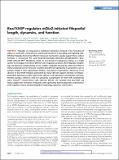Ena/VASP regulates mDia2-initiated filopodial length, dynamics, and function
Author(s)
Barzik, Melanie; McClain, Leslie Marie; Gupton, Stephanie L.; Gertler, Frank
DownloadBarzik-2014-Ena_VASP regulates m.pdf (2.979Mb)
PUBLISHER_CC
Publisher with Creative Commons License
Creative Commons Attribution
Terms of use
Metadata
Show full item recordAbstract
Filopodia are long plasma membrane extensions involved in the formation of adhesive, contractile, and protrusive actin-based structures in spreading and migrating cells. Whether filopodia formed by different molecular mechanisms equally support these cellular functions is unresolved. We used Enabled/vasodilator-stimulated phosphoprotein (Ena/VASP)–deficient MV[superscript D7] fibroblasts, which are also devoid of endogenous mDia2, as a model system to investigate how these different actin regulatory proteins affect filopodia morphology and dynamics independently of one another. Filopodia initiated by either Ena/VASP or mDia2 contained similar molecular inventory but differed significantly in parameters such as number, length, F-actin organization, lifetime, and protrusive persistence. Moreover, in the absence of Ena/VASP, filopodia generated by mDia2 did not support initiation of integrin-dependent signaling cascades required for adhesion and subsequent lamellipodial extension, thereby causing a defect in early cell spreading. Coexpression of VASP with constitutively active mDia2[superscript M/A] rescued these early adhesion defects. We conclude that Ena/VASP and mDia2 support the formation of filopodia with significantly distinct properties and that Ena/VASP regulates mDia2-initiated filopodial morphology, dynamics, and function.
Date issued
2014-07Department
Massachusetts Institute of Technology. Department of Biological Engineering; Massachusetts Institute of Technology. Department of Biology; Koch Institute for Integrative Cancer Research at MITJournal
Molecular Biology of the Cell
Publisher
American Society for Cell Biology
Citation
Barzik, M., L. M. McClain, S. L. Gupton, and F. B. Gertler. “Ena/VASP Regulates mDia2-Initiated Filopodial Length, Dynamics, and Function.” Molecular Biology of the Cell 25, no. 17 (July 2, 2014): 2604–2619.
Version: Final published version
ISSN
1059-1524
1939-4586